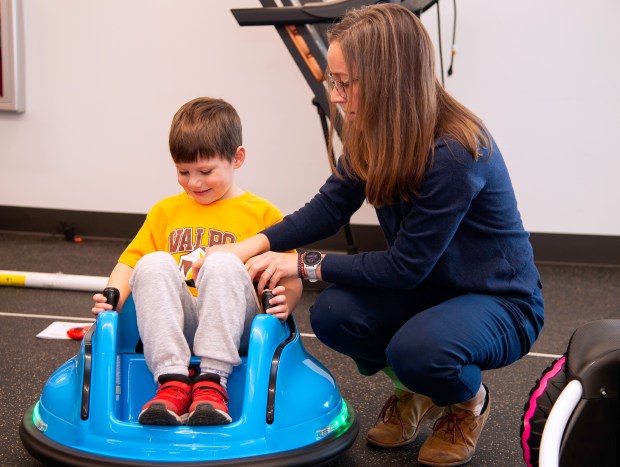[ad_1]
On Wednesday morning, Nolan and Sean Carroll, ages 4½ and 3, respectively, giggled happily as they strolled in the sunlight on the large black rubber mat at Valparaiso University’s Gellersen Center School of Engineering Bioengineering Laboratory.
Typically developing preschoolers were there to help with the first step of providing modified motor cars to their disabled peers.
The goal was to observe how the boys were finding a way to run commercially produced cars, as occupational health graduate students and bioengineering students prepared for an effort to modify off-the-shelf cars to fit the needs of children with disabilities. Local effort for national GoBabyGo! attempt.
The University of Delaware launched the program and has published open source guidelines for anyone who wants to use them.
Reva Johnson, an associate professor of mechanical engineering and bioengineering at VU, has been involving her students since 2017, when her senior design students began collaborating with the Shirley Ryan Talent Lab in Chicago. This is the first year they have worked at VU in partnership with occupational health doctoral students from the Faculty of Nursing and Health Professions.
For typically developing children, a ride-on vehicle can be a great toy, while for children with disabilities, it can be a mobility aid that fills the gap left when pediatric electric wheelchairs, which often cost tens of thousands of dollars, take a long time to be approved. It grows rapidly and becomes inaccessible due to insurance. Even those who do not require a wheelchair can benefit from a modified ride vehicle.
“There’s a population of kids who don’t need a wheelchair but aren’t mobile enough to keep up with other kids,” said Theresa Carroll, the Carroll Boys’ mother and clinical associate professor of occupational therapy at VU. “As soon as a baby begins to crawl, he or she has control over his or her world. “A lot of brain development happens through mobility,” she added. “Once you can move, your vision becomes different while you are in motion.”
VU GoBabyGo! The group is looking for families who would like to apply for a modified motor car for their children. The acceptable age range varies depending on the weight limits of various vehicles, children’s unique physiques, and whether different models can be modified to suit individual children’s specific needs, but the group envisions helping children from 18 months onwards. Up to 10-12 years old.

The plan is to have three to five selected children come to try different models, take measurements and determine what modifications will be needed to make the vehicle work for the child. The goal is to provide rides to families at no cost, using commercially available tools.
Tools can also be modified to meet a specific therapeutic need, such as placing a controller in a specific spot to exercise a specific muscle group. For example, one vehicle Nolan drove used a foam swim board behind him to further support him and help him sit more upright. Once the vehicles are ready, the children will be brought back to the laboratory for necessary fine-tuning and the keys will be delivered by May 4.
The toys are fairly simple to engineer, said Quinn Brothers, a senior biomedical specialist from Canton, Michigan. “Everything varies from child to child, so making it all work for them is probably the most complicated part.”
Peyton Throw, a first-year occupational therapy doctoral student from Rochester Hills, Michigan, along with fellow doctoral student Maria Camacho from LaPorte, evaluated how children used two cars. “I think that’s the one with the most adaptability potential,” he said of a pink Jeep-like model.
“The spinning thing might be good for sensory integration,” Camacho replied. “You can tell the difference between Sean and Nolan on this one.”

“He drives with his elbows now,” Throw said, leading all the collaborators into another conversation about how cars could be adapted for children with missing limbs.
Application for VU GoBabyGo! The selection process can be found here: https://forms.gle/6yqTf6r3u3enQ32y5.
You can find more general information about the program at: https://www.valpo.edu/college-of-nursing-and-health-professions/2024/02/14/gobabygo-launching-at-valpo/.
“Founders of GoBabyGo! We argue very strongly that mobility is a human right,” Carroll said.
Shelley Jones is a freelance reporter for the Post-Tribune.
 Best American Comics News bestamericancomics.com started its broadcasting life on December 21, 2022 and aims to offer original content to users. Aiming to share information in technology, science, education and other fields, bestamericancomics.com aims to provide its readers with the most up-to-date and comprehensive. Since the content of the site is created by expert writers, readers are reliable and accurate referrers.
Best American Comics News bestamericancomics.com started its broadcasting life on December 21, 2022 and aims to offer original content to users. Aiming to share information in technology, science, education and other fields, bestamericancomics.com aims to provide its readers with the most up-to-date and comprehensive. Since the content of the site is created by expert writers, readers are reliable and accurate referrers.





